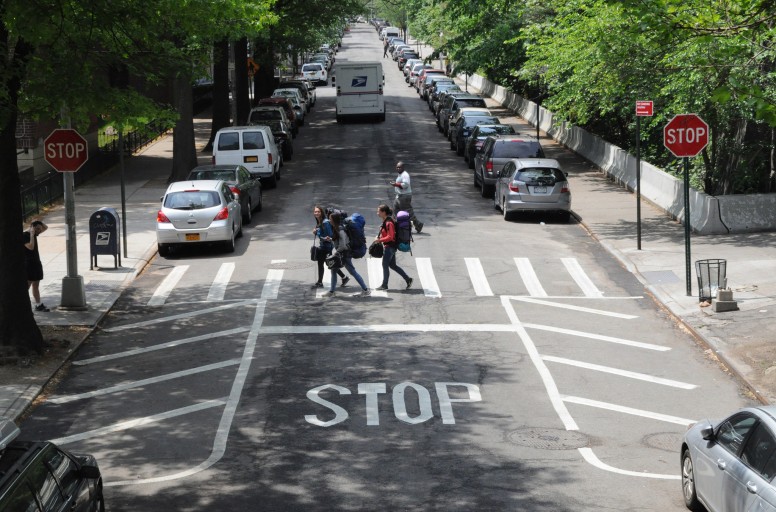The White House and USDOT issued a call-to-action to address the significant uptick in traffic fatalities last year. New data from the National Highway Traffic Safety Administration (NHTSA) reveals that 35,092 people died in traffic during 2015, a 7.2 percent increase compared to 2014.
The uptick marks the reverse of a general decline in traffic deaths over the past several years. Fatalities involving pedestrians and bicyclists also increased significantly, by 9.5 percent and 12.2 percent, respectively. Pedestrians and bicyclists already account for more than a quarter of traffic deaths in New York and New Jersey, and 15 percent in Connecticut. American motorists also drove 3.5 percent more miles compared to 2014, marking the largest increase in nearly 25 years. NHTSA attributed the hike in miles traveled to lower unemployment and cheaper gas prices.
USDOT is enlisting help from interested non-profits, data scientists, planners and concerned citizens alike to explore topics such as how to identify communities at risk for fatal crashes; how climate change might increase the risk for fatal crashes; how to change dangerous behaviors behind the wheel; and how to monitor and address indicators for fatal crashes.
But the best time to act has already passed. 2016 is already shaping up to be even more deadly than 2015. Reversing the current upward trend would require immediate action and a serious investment toward building out safer infrastructure, especially for people walking and biking. Here in the region, New York dedicated $110 million over five years to pedestrian safety throughout the state (except New York City) earlier this year. But in New Jersey, where traffic deaths have risen for the past two years, lawmakers have yet to present a viable solution to end the transportation funding shutdown.
Celebrate the region’s biggest and boldest recent transportation initiatives at TSTC’s 2016 Benefit on September 27. Get your tickets here.


This “the world is ending” nonsense by the ‘safety” advocates without mention that the decrease that occurred after 2007.was ECONOMIC! Needs to stop. The 2015 increase is ECONOMIC!
Just compare 2007 to 2008 the year the recession hit. The deaths dropped from 41,259 to 37,423 DUE TO THE ECONOMY!
That was a close to a 4,000 drop in ONE YEAR because of the start of the RECESSION!
That was a RECESSION DROP!
http://www-fars.nhtsa.dot.gov/Main/index.aspx
The 2007 was also last time we had a record driving year till 2015.
It is really important to NOT compare 2015 to the recession years as any comparison to 2008 to 2014 numbers SKEW the results due the recession affecting the numbers.
Here are 2006 thur 2014.
http://www-fars.nhtsa.dot.gov/Main/index.aspx
2006 US Death rate per mile 1.42 Total Deaths 42,708 Miles Driven 3.014 Trillion (3,014 VMT Billion)
2007 US Death rate per mile 1.36 Total Deaths 41,259 Miles Driven 3.031 Trillion
Recession Begins
2008 US Death rate per mile 1.26 Total deaths 37,423. Miles Driven 2.977 Trillion (2,977 VMT Billion)
Full year of recession
2009 US Death rate per mile 1.15 Total deaths 33,883. Miles Driven 2.957 Trillion
2010 US Death rate per mile 1.11 Total deaths 32,999. Miles Driven 2.967 Trillion
2011 US Death rate per mile 1.10 Total deaths 32,479. Miles Driven 2.950 Trillion
2012 US Death rate per mile 1.14 Total deaths 33,782. Miles Driven 2.969 Trillion
2013 US Death rate per mile 1.10 Total deaths 32,894. Miles Driven 2,988 Trillion
Starting to leave Recession
2014 US Death rate per mile 1.08 Total deaths 32,675. Miles Driven 3.026 Trillion (3,026 VMT Billion)
The cause is driving miles increasing with more DUI, younger drivers, and more discretionary driving.
Also it is important to mention the DR per mile! It was 1.12 for 2015, lower than 2012 which was 1.14!
http://www.motorists.org
[…] attention to pedestrian safety wasn’t the stated purpose of Murphy’s walk, though it could not have been better timed if it were: On the day his trek began, the National Highway Traffic Safety Administration […]
Stephen makes an excellent point . we have all been living in la la land in the last 8 years only too happy to believe that the feeble measures put in place were responsible for the decrease.
this points to the fundamental culprit: the individual car and truck which not only causes environmental havoc but also a massive human tragedy while ti continues to be heavily subsidized by the government in terms of roads , cheap gas etc..
It is now critical we drastically reduce vehicles miles per person travelled if we want to address the problems: a heavy tax on miles traveled per type of vehicles combined with a tax on high consumption high emission vehicles would do the trick.
These funds should go mainly to state and municipalities to build whatever mode of transportation their residents see fit.
I call it Over population, the suburbs like on Long Island is out of control and just keeps getting worse.
(So sad)
[…] week, the White House and the U.S. Department of Transportation issued a call-to-action in response to the significant uptick in 2015 traffic deaths. And as oil prices and unemployment […]